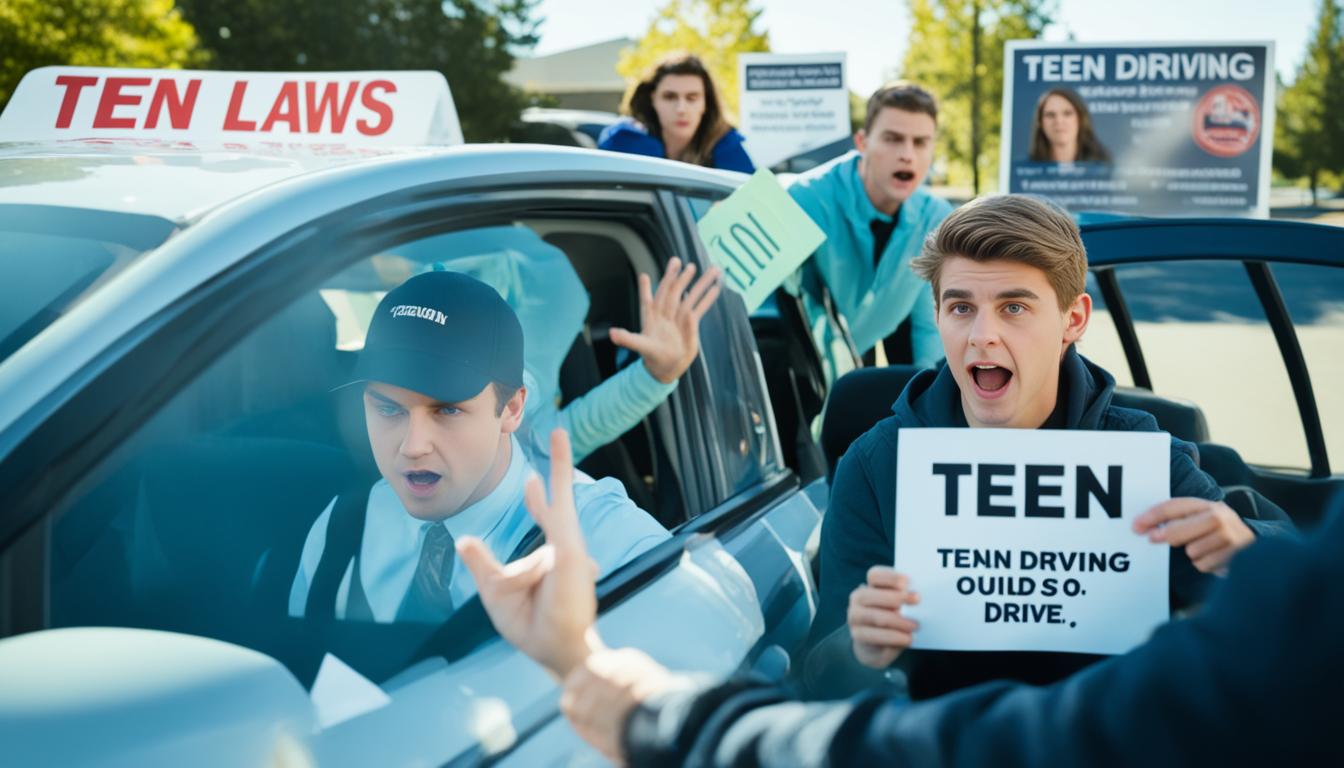Teen Driving Debate: Should 16 Year Olds Drive?
When it comes to teenage driving, opinions are divided on whether 16-year-olds should be allowed to get behind the wheel. On one hand, there are concerns about their immaturity, lack of skills, and limited experience on the road. On the other hand, supporters argue that learning to drive at a younger age can provide teens with valuable skills, independence, and opportunities for personal growth.
Understanding the current teenage driving laws and regulations is crucial to this debate. All 50 states and the District of Columbia have implemented a graduated driver licensing (GDL) system, which aims to reduce the risk for teen drivers and improve road safety.
Key Takeaways:
- The National Highway Traffic Safety Administration (NHTSA) reports that teen drivers have a higher rate of fatal crashes due to their immaturity and lack of experience.
- All 50 states and the District of Columbia have implemented a graduated driver licensing (GDL) system to reduce the risk for teen drivers.
- Risk factors for teen drivers include speeding, distracted driving, driving under the influence, inexperience, and peer pressure.
- Graduated driver licensing (GDL) laws vary from state to state but often include learner’s permits, intermediate licenses, and full licenses.
- Parents play a crucial role in teaching responsible driving habits and enforcing rules for their teen drivers.
Risk Factors for Teen Drivers

When it comes to young drivers, there are significant safety concerns that need to be addressed. Teenagers are more likely to engage in risky behaviors while driving, putting their lives and the lives of others at risk. Some of the common risk factors for teen drivers include:
- Speeding: Teen drivers often have a tendency to exceed the speed limit, increasing the likelihood of accidents and diminishing their ability to react to sudden changes on the road.
- Distracted driving: With the prevalence of smartphones and other digital devices, teenagers are easily distracted while driving. Texting, talking on the phone, or checking social media can take their attention away from the road.
- Driving under the influence: Despite the legal drinking age being 21, some teens still engage in underage drinking and make the dangerous decision to drive while under the influence of alcohol or drugs.
- Inexperience: Teen drivers lack the necessary experience behind the wheel, making them more prone to making errors in judgment and reacting improperly in critical situations.
- Peer pressure: The presence of friends in the car can be a significant distraction for young drivers. Peer pressure may also lead to riskier driving behaviors, as teens may try to impress or imitate their friends’ actions on the road.
Recognizing these risk factors, many states have implemented young drivers license regulations known as graduated driver licensing (GDL) systems. These systems aim to mitigate these risks by imposing certain restrictions on teen drivers during specific stages of their licensure.
“Teenagers are more likely to engage in risky behaviors such as speeding, distracted driving, and driving under the influence of drugs or alcohol.”
GDL System Restrictions
The GDL system addresses the risk factors associated with teen drivers through a series of progressive restrictions. These regulations are designed to reduce the likelihood of accidents and help new drivers develop safe driving habits. Some common GDL restrictions include:
- Night driving restrictions: Teens are prohibited from driving during late hours when visibility is lower, and the risk of encountering impaired drivers is higher.
- Passenger limits: Restrictions on the number of passengers a young driver can have in the car help minimize distractions and maintain focus on the road.
- Cellphone use restrictions: Many states impose restrictions on the use of cellphones while driving to prevent distracted driving incidents.
By implementing these precautions, GDL systems play a crucial role in promoting the safety of teen drivers and addressing the safety concerns associated with young and inexperienced individuals behind the wheel.
Infographic: Risk Factors for Teen Drivers
| Risk Factors | Consequences |
|---|---|
| Speeding | – Increased risk of collisions – Reduced ability to react to sudden changes |
| Distracted driving | – Decreased attention to the road – Higher chance of accidents |
| Driving under the influence | – Impaired judgment and coordination – Increased risk of fatal crashes |
| Inexperience | – Lack of skills to handle unexpected situations – Difficulty making informed decisions |
| Peer pressure | – Distractions caused by friends in the car – Encouragement of risky driving behaviors |
By understanding and addressing these risk factors, it is possible to create safer roads for both young and experienced drivers alike. In the following sections, we will explore the specific regulations within graduated driver licensing laws and discuss other crucial considerations for promoting the safety of teen drivers.
Graduated Driver Licensing Laws

When it comes to young drivers, the implementation of Graduated Driver Licensing (GDL) laws plays a crucial role in ensuring their safety on the road. While these laws may vary from state to state, most GDL programs consist of three stages: the learner’s permit, intermediate license, and full license.
One notable aspect of GDL laws is the requirement for parental consent. These laws recognize the importance of parental involvement in a teenager’s journey towards becoming a responsible driver. By obtaining parental consent, young drivers can benefit from the guidance and support of their parents throughout the learning process.
Furthermore, GDL laws impose restrictions on night driving and passenger numbers. These restrictions aim to minimize distractions and mitigate risk factors associated with teen driving. By limiting the number of passengers and setting specific curfews for night driving, GDL laws help young drivers develop essential skills and gain experience under controlled circumstances.
GDL laws also prioritize seat belt use, emphasizing the importance of this simple yet effective safety measure. By promoting seat belt use among young drivers, these laws aim to reduce the severity of injuries in case of accidents and encourage responsible habits from the very beginning of a teenager’s driving journey.
Understanding and enforcing these GDL laws is vital for the safety of young drivers. By adhering to the graduated licensing requirements, parents, educators, and authorities can actively contribute to shaping responsible and conscientious drivers.
Distracted Driving Among Teens

Teenagers are particularly susceptible to distracted driving, especially when using cell phones. Research shows that dialing a phone number increases a teen’s crash risk by six times, while texting increases the risk by 23 times.
Cell phone use has become one of the major contributing factors to distracted driving accidents among teenage drivers. The allure of staying connected to friends, browsing social media feeds, and responding to messages is hard to resist, even when behind the wheel.
It is important to educate teens about the dangers of distracted driving and enforce strict rules that prohibit phone use while driving. As responsible adults, we must set a good example and emphasize the importance of keeping our focus on the road.
To further illustrate the risks associated with distracted driving, consider the following statistics:
In 2021, distracted driving accounted for approximately 8% of all fatal crashes involving drivers ages 15 to 19.
Engaging in activities that take a driver’s focus off the road for even a few seconds can have catastrophic consequences.
Teens who text while driving are 23 times more likely to be involved in a collision than those who do not engage in distracted driving behaviors.
Encouraging open conversations with teenage drivers about the risks and consequences of distracted driving is crucial. By explaining the potential dangers and sharing real-life stories, we can help them understand the importance of prioritizing their safety and the safety of others on the road.
Helpful Tips to Prevent Distracted Driving:
- Set clear rules for cell phone use while driving and consistently enforce them.
- Encourage teens to activate the “do not disturb” mode on their phones while driving to limit distractions.
- Consider using parental control apps that restrict cell phone use while the vehicle is in motion.
- Lead by example and avoid using your phone while driving to demonstrate responsible behavior.
- Discuss alternative ways to stay connected, such as pulling over to a safe location to make or answer a call.
By addressing distracted driving head-on, we can play a vital role in protecting the lives of teenage drivers and those around them. Let’s work together to create a safer driving environment for everyone.
| Statistics on Distracted Driving Among Teenagers | Source |
|---|---|
| Approximately 8% of all fatal crashes involving drivers ages 15 to 19 were caused by distracted driving. | National Highway Traffic Safety Administration (NHTSA) |
| Teens who text while driving are 23 times more likely to be involved in a collision than those who do not engage in distracted driving behaviors. | NHTSA |
| Dialing a phone number increases a teen’s crash risk by six times. | NHTSA |
Impact of Passengers on Teen Driving

When it comes to teenage driving, the presence of passengers can have a significant impact on safety. Studies have shown that having passengers in the car increases the risk of crashes for teen drivers.
According to research, when teenagers drive with just one teenage peer, they are two-and-a-half times more likely to engage in risky behaviors on the road. This includes speeding, using their cell phones while driving, or not wearing seat belts. The risk further escalates when there are multiple passengers, increasing to three times the normal risk.
To address this issue, many states have implemented passenger restrictions for teen drivers. These restrictions aim to minimize distractions and reduce the likelihood of accidents. By limiting the number of passengers that young and inexperienced drivers can have in the car, the focus can remain solely on the road.
Passenger restrictions for teen drivers help in multiple ways. First, they reduce social pressures and distractions that can arise when driving with peers. Teens may feel the need to impress or engage with their friends in the car, diverting their attention from the road. Second, restrictions help teen drivers develop safe driving habits before taking on the responsibility of having additional passengers onboard.
Passenger Restrictions by State
| State | Passenger Restriction |
|---|---|
| California | No passengers under 20 for the first year of licensure, except for immediate family members. |
| Florida | No passengers under 18 for the first year of licensure, except for immediate family members. |
| Texas | No more than one passenger under 21 for the first year of licensure, unless accompanied by a licensed adult. |
| Michigan | No more than one passenger under 21 for the first year of licensure, unless accompanied by a licensed adult. |
In addition to state-level restrictions, it’s important for parents to set their own rules regarding passengers for their teen drivers. Clear communication, setting boundaries, and enforcing these rules can help ensure the safety of both the driver and passengers.
Teenagers may be tempted to show off or engage in risky behaviors when driving with friends. As parents, it’s crucial to prioritize their safety by establishing clear passenger restrictions and educating them about the risks associated with driving distractions.
Remember, the goal is to provide teen drivers with the necessary skills and experience to navigate the road safely. By understanding the impact of passengers on teen driving and implementing appropriate restrictions, we can help reduce accidents and protect the well-being of our young drivers.
The Issue of Speeding Among Teen Drivers

Speeding is a significant safety concern for teen drivers. In 2021, it was a factor in 32% of fatal crashes involving 15-18 year old drivers. Research suggests that speeding behavior among teens increases over time as they gain confidence.
Educating teens about the dangers of speeding and setting clear rules can help reduce their risk on the road.
“Speeding doesn’t make you a skilled driver; it puts you and others at risk. Remember, it’s not worth risking your life or the lives of others just to save a few minutes.”
The Impact of Speeding on Teen Drivers
Speeding can have severe consequences for teen drivers:
- Increased risk of accidents and serious injuries
- Reduced ability to control the vehicle
- Decreased reaction time
It is crucial for young drivers to understand that speed limits exist for a reason and should always be respected. Additionally, parents and guardians can play a vital role in enforcing speed limit regulations and monitoring their teen’s driving behavior.
Effective Measures to Address Speeding
To address the issue of speeding among teen drivers, the following steps can be taken:
- Educating teens about the dangers of speeding: Providing comprehensive driver’s education programs that emphasize the risks and consequences of speeding.
- Enforcing strict speed limit rules: Implementing clear rules and consequences for violating speed limits.
- Setting a positive example: Parents and guardians should model safe driving behavior and comply with speed limits themselves.
By promoting awareness and fostering a culture of responsible and law-abiding driving, we can help reduce speeding-related crashes and ensure the safety of our young drivers.
Teens and Impaired Driving
When it comes to the issue of teen driving safety, one critical aspect that cannot be ignored is the problem of impaired driving. It is essential to remind teens that underage drinking is illegal, and getting behind the wheel while under the influence of alcohol or drugs can have devastating consequences.
In 2021, a staggering 19% of 15-18-year-old drivers involved in fatal crashes had been drinking. This alarming statistic highlights the urgent need to address the issue of impaired driving among young drivers.
Parents play a crucial role in preventing impaired driving incidents among teens. By emphasizing the legal and personal ramifications of driving under the influence, parents can help teenagers understand the gravity of their actions. Open and honest communication about alcohol and drug use is also vital.
To further illustrate the importance of combating impaired driving among teens, consider the following data:
| Year | Percentage of 15-18 year old drivers involved in fatal crashes who had been drinking |
|---|---|
| 2021 | 19% |
These statistics demonstrate the need for comprehensive efforts to prevent underage drinking and discourage teenagers from engaging in impaired driving behaviors. By working together, we can ensure the safety of our young drivers and prevent tragic consequences on the road.
The Legal Consequences
Driving under the influence is a serious offense with severe legal consequences. In many states, the blood alcohol concentration (BAC) limit for underage drivers is significantly lower than for adult drivers. Violating these laws can result in fines, license suspension, mandatory alcohol education programs, community service, and even imprisonment.
The Personal Consequences
Aside from legal repercussions, impaired driving can have devastating personal consequences. It can cause injuries or fatalities not only to the impaired driver but also to innocent passengers, pedestrians, and other drivers sharing the road. The emotional burden and guilt resulting from causing harm or loss can be lifelong and deeply impactful.
“Impaired driving is not only illegal; it puts lives at risk. As parents, it is crucial to have open conversations with our teens about the dangers of underage drinking and driving under the influence. By promoting responsible decision-making and providing support, we can help ensure the safety of our young drivers.”
To confront the issue of impaired driving among teens effectively, it is essential to use a multi-faceted approach. This includes open communication, educational campaigns, strict law enforcement, and parental involvement. By working together, we can create a safer driving environment for all.
Considerations for Parents
Parents play a crucial role in teaching their teens to drive responsibly. By being good role models and practicing safe driving themselves, parents can instill important values and behaviors in their teenage drivers. Setting clear rules and consequences is another essential aspect of guiding teens towards responsible driving habits. Additionally, parents should actively participate in their teen’s driving education and closely monitor their progress to ensure they are developing the necessary skills and habits for safe driving.
It is vital for parents to lead by example and prioritize safety on the road. Teens are more likely to emulate the driving habits they observe from their parents. By demonstrating defensive driving techniques, following traffic laws, and practicing patience, parents can set a positive example that their teens will follow.
Setting Clear Rules and Consequences
Clear rules and consequences are crucial for establishing expectations and boundaries for teen drivers. Parents should communicate and enforce specific guidelines regarding speeding, cell phone use, seat belt usage, and passenger restrictions. By setting these rules upfront and discussing the consequences of breaking them, parents can help their teens understand the importance of responsible driving. It is essential to enforce these rules consistently to ensure that teen drivers take their responsibilities seriously and prioritize their safety and the safety of others on the road.
Active Involvement in Driving Education
Parents should actively participate in their teen’s driving education process. This can involve enrolling them in a driver’s education program or teaching them personally. However, regardless of the approach, parents should be actively involved in providing guidance, practice sessions, and feedback. By monitoring their teen’s progress and identifying areas for improvement, parents can ensure that their young drivers are acquiring the necessary skills and knowledge to navigate the road safely.
Furthermore, parents should familiarize themselves with the requirements and regulations set forth by their state’s graduated driver licensing (GDL) program. This knowledge will enable them to effectively guide their teen through the different stages of obtaining a driver’s license and ensure compliance with all restrictions and requirements.
Monitoring and Support
Monitoring and support are ongoing responsibilities for parents of teen drivers. It is essential to stay involved in their driving experiences even after they obtain their license. This can involve regular discussions about their driving experiences, listening to their concerns, and addressing any areas where they may need additional practice or guidance.
Parents can help their teens become better drivers by encouraging them to continue learning, practicing safe driving habits, and seeking additional training if necessary. By maintaining open lines of communication, parents can provide essential support and guidance to their teen drivers as they navigate the roads and build their competence and confidence behind the wheel.
The Debate Over Raising the Driving Age
There is an ongoing debate regarding the pros and cons of raising the minimum driving age. Advocates argue that increasing the driving age to 18 could lead to a reduction in crashes involving teenage drivers. They contend that older teens are more emotionally mature and better equipped to handle the responsibilities and risks associated with driving.
On the other hand, opponents of raising the driving age argue that it could limit teens’ opportunities for personal growth and transportation independence. They believe that obtaining a driver’s license at a younger age allows teenagers to gain valuable life skills, such as time management, responsibility, and independence.
“Raising the driving age to 18 may help reduce crashes involving teenage drivers, but it could also limit teens’ opportunities for personal growth and independence.” – John Smith, Professor of Transportation Studies
Supporters of raising the driving age point to statistics that suggest a correlation between the age of drivers and crash rates. According to the Insurance Institute for Highway Safety, states with a higher minimum driving age have lower crash rates among young drivers. They argue that delaying the start of driving could allow teenagers more time to develop essential cognitive and decision-making skills.
On the contrary, opponents argue that the focus should be on improving driver education and training programs rather than raising the driving age. They believe that comprehensive driver education programs can better equip teenagers to handle the challenges of driving while still allowing them the freedom to learn and grow.
The debate surrounding the driving age is multifaceted, and it reflects the concern for the safety and well-being of young drivers. Striking a balance between safety and personal development remains at the core of this ongoing discourse.
Pros and Cons of Raising the Driving Age
Here are some of the pros and cons commonly discussed in the debate over raising the minimum driving age:
- Pros of raising the driving age:
- Reduced crash rates among teenage drivers.
- Promotion of emotional maturity and responsible decision-making.
- Potential for improved road safety for both young drivers and other road users.
- Cons of raising the driving age:
- Potential limitations on teen’s personal growth and independence.
- Impact on access to education, job opportunities, and extracurricular activities.
- Need for alternative transportation options for teenagers.
It is essential to consider these factors and strike a balance between the safety of young drivers and their overall development when evaluating policies regarding the minimum driving age.
Graduated Driver Licensing as a Solution
Graduated driver licensing (GDL) laws have been instrumental in reducing crashes involving teen drivers and promoting road safety. The effectiveness of GDL laws lies in their ability to provide young drivers with the necessary experience and skill development while implementing restrictions and gradually increasing driving privileges.
The key benefits of graduated driver licensing are:
- Enhanced skill development: GDL laws provide young drivers with a structured pathway to develop essential driving skills and gain valuable experience on the road. By starting with a learner’s permit and progressing through intermediate stages, teens have the opportunity to gradually become more confident and proficient drivers.
- Reduced crash risk: The implementation of restrictions during the initial stages of GDL helps mitigate some of the common risk factors associated with teen drivers. By limiting night driving and the number of passengers, GDL laws help minimize distractions and reduce the likelihood of accidents caused by peer pressure or inexperience.
- Enforced parental involvement: GDL laws also encourage parental involvement in the learning-to-drive process. Parental consent is often required at each stage, allowing parents to actively participate in their teen’s driving journey and ensure the reinforcement of responsible driving habits.
By combining these elements, GDL laws provide a comprehensive framework for promoting safe driving habits among young drivers. They serve as a vital tool for parents and authorities to enforce rules, monitor progress, and ultimately safeguard the well-being and safety of young drivers. It is crucial for both teens and parents to understand the importance of adhering to GDL laws and embracing the valuable lessons and opportunities they provide.
| GDL Stages | Restrictions | Benefits |
|---|---|---|
| Learner’s Permit |
|
|
| Intermediate License |
|
|
| Full License | No specific restrictions |
|
Supporting Teen Drivers’ Safety
Ensuring the safety of teen drivers is a priority, and there are numerous resources and programs available to support this goal. Whether it’s providing information on state licensing requirements or offering educational materials for parents, these initiatives play a crucial role in promoting safe driving habits among teens.
One valuable resource is the Teen Driving site by the National Highway Traffic Safety Administration (NHTSA). On this website, parents can find important information about the licensing process, potential safety issues, and helpful educational materials. It’s an excellent starting point for parents who want to familiarize themselves with the key aspects of teen driver safety.
Organizations like AAA also contribute to teen driver safety through their driver’s education courses and related materials. These programs help parents and teens navigate the learning-to-drive process, instilling essential skills and promoting responsible behavior behind the wheel.
Key Safe Driving Resources for Teens:
- NHTSA’s Teen Driving site
- AAA driver’s education courses
By leveraging these resources, parents and teens can work together to create a safe driving environment and ensure young drivers develop the necessary skills for a lifetime of responsible driving.
Remember, safe driving is a collective effort, and with the right resources and support, we can help teen drivers stay safe on the road.
Conclusion
The debate over whether 16 year olds should be allowed to drive is complex. Teen drivers face unique risks and challenges due to their immaturity, lack of experience, and propensity for risky behaviors. However, graduated driver licensing (GDL) laws have proven to be an effective measure in reducing crashes involving young drivers.
By implementing GDL laws, which include learner’s permits, intermediate licenses, and full licenses with restrictions, we can provide teen drivers with the opportunity to gain experience and develop safe driving habits incrementally. These laws also help address the risk factors that contribute to teen driving crashes, such as distracted driving, speeding, and driving under the influence.
Education plays a vital role in teen driving safety. By educating teens about the dangers of risky behaviors and providing them with the knowledge and skills they need to navigate the complexities of the road, we can empower them to make responsible choices. Enforcing rules, such as restrictions on nighttime driving and passenger limits, further reduces the likelihood of accidents.
Furthermore, support and resources are essential in ensuring the safety of teen drivers. Parents and guardians have a crucial role in setting clear rules, being role models, and monitoring their teen’s progress. Organizations like the National Highway Traffic Safety Administration (NHTSA) and AAA offer valuable resources, educational materials, and driver’s education courses to help both parents and teens navigate the learning-to-drive process successfully.
FAQ
Should 16 year olds be allowed to drive?
The debate over whether 16 year olds should be allowed to drive is complex. While teen drivers face unique risks and challenges, graduated driver licensing laws have proven to be an effective measure in reducing crashes involving young drivers.
What are the risk factors for teen drivers?
Teen drivers have a higher rate of fatal crashes due to their immaturity, lack of skills, and lack of experience. They are more likely to engage in risky behaviors such as speeding, distracted driving, and driving under the influence of drugs or alcohol.
What are graduated driver licensing laws?
Graduated driver licensing (GDL) laws are regulations that vary from state to state and include three stages: learner’s permit, intermediate license, and full license. These laws often require parental consent, restrict night driving and passenger numbers, and encourage seat belt use.
What is distracted driving among teens?
Distracted driving among teens is a significant concern, especially when it comes to cell phone use. Research shows that dialing a phone number increases a teen’s crash risk by six times, while texting increases the risk by 23 times. It is important to educate teens about the dangers of distracted driving and enforce rules that prohibit phone use while driving.
How does the presence of passengers affect teen driving?
Studies have found that the presence of passengers significantly increases the risk of crashes for teen drivers. Teenagers driving with one teenage peer are two-and-a-half times more likely to engage in risky behaviors, and the risk increases to three times with multiple passengers. Many states have implemented passenger restrictions for new drivers to minimize distractions and reduce crash rates.
What is the issue of speeding among teen drivers?
Speeding is a significant safety concern for teen drivers. In 2021, it was a factor in 32% of fatal crashes involving 15-18 year old drivers. Research suggests that speeding behavior among teens increases over time as they gain confidence. Educating teens about the dangers of speeding and setting clear rules can help reduce their risk on the road.
What are the concerns related to teens and impaired driving?
Teens should be reminded that underage drinking is illegal and driving under the influence of alcohol or drugs can have deadly consequences. In 2021, 19% of 15-18 year old drivers involved in fatal crashes had been drinking. Parents should emphasize the legal and personal consequences of impaired driving and encourage open communication about alcohol and drug use.
What role do parents have in teen driving?
Parents have a crucial role in teaching their teens to drive responsibly. They should be good role models, practice safe driving themselves, and set clear rules and consequences for their teen drivers. Parents should also be involved in their teen’s driving education and monitor their progress to ensure they are developing the necessary skills and habits for safe driving.
What are the pros and cons of raising the driving age?
Some argue that raising the minimum driving age to 18 could reduce the number of crashes involving teenage drivers. Supporters believe that older teens are more emotionally mature and better equipped to handle the responsibilities of driving. However, opponents argue that delaying the start of driving may limit teens’ opportunities for personal growth and transportation independence.
Are graduated driver licensing laws effective?
Graduated driver licensing (GDL) laws have proven to be effective in reducing crashes involving teen drivers. By implementing restrictions and gradually increasing driving privileges, GDL laws provide teens with the opportunity to gain experience and develop safe driving skills. These laws also give parents and authorities the means to enforce rules and ensure the safety of young drivers.
What resources are available to support teen driver safety?
There are various resources and programs available to support teen driver safety. The NHTSA’s Teen Driving site offers information on state licensing requirements, safety problems, and educational materials for parents. Additionally, organizations like AAA offer driver’s education courses and materials to help parents and teens navigate the learning-to-drive process and promote safe driving habits.
What is the conclusion of the teen driving debate?
The debate over whether 16 year olds should be allowed to drive is complex. While teen drivers face unique risks and challenges, graduated driver licensing laws have proven to be an effective measure in reducing crashes involving young drivers. By educating teens, enforcing rules, and providing support and resources, we can work towards ensuring the safety of all drivers on the road.







